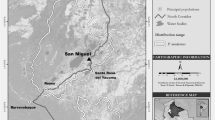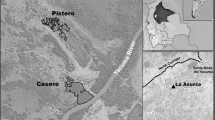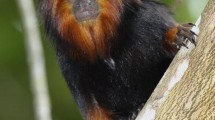Abstract
We present data on aspects of the behavioral ecology of a free- ranging group of Saguinus fuscicollis weddelliat a site in Brazilian Amazonia where a second callitrichid, Callithrix emiliae,is syntopic. Diet, activity patterns, and ranging behavior are broadly similar to those of S. fuscicollisfrom sites in Bolivia, Brazil, and Perú, though significant seasonal changes include an extreme and atypical form of ranging behavior in which they foraged in central-place fashion around a source of exudate—Parkia pendula. S. f. weddelliwas active at relatively low levels in the forest both in absolute terms and relative to C.emiliae, which appears to be an important factor in their niche partitioning. Association between the two species appeared to be less systematic overall than those observed between S. fuscicollisand congeners at other sites, though this may be partly a result of observation conditions. During the period of central-place foraging, the two species exhibited a high degree of association. Other characteristics of the behavior of S. f. weddelliat the study site include the frequent use of tree holes as sleeping sites.
Similar content being viewed by others
References
Altmann, J. (1974). Observational study of behaviour: sampling methods.Behaviour 49: 227–242.
Buchanan-Smith, H. (1990). Polyspecific association of two tamarin species,Saguinus labiatus andSaguinus fuscicollis, in Bolivia.Am. J. Primatol. 22: 205–214.
Coimbra-Filho, A. F. (1977). Natural shelters ofLeontopithecus rosalia and some ecological implications (Callitrichidae, Primates). In Kleiman, D. G. (ed.),The Biology and Conservation of the Callitrichidae, Smithsonian Institution Press, Washington, DC, pp. 79–89.
Crandlemire-Sacco, J. L. (1986).The Ecology of the Saddle-Back Tamarin, Saguinus fuscicollis,of Southeastern Peru, Ph.D. these, University of Pittsburgh, Pittsburgh,
de Vivo, M. (1985). On some monkeys from Rondonia, Brasil (Primates: Callitrichidae, Cebidae).Pap. Av. ZooL Mus. Zool. Univ. S. Paulo 36: 103–110.
Fang, T. G. (1990). La importancia de los frutos en la dieta deSaguinus mystax yS. fuscicollis (Primates, Callitrichidae), en el Rio Tahuayo, departmento de Loreto, Peru. InLe Primatologia en el Peru, Investigaciones Pritnatologicas (1973-1985). Proyecto Peruano de Primatologia “Manuel Moro Sommo,” Lima, Perú, pp. 342–358.
Ferrari, S. F. (1988).The Behaviour and Ecology of the Buffy- Headed Marmoset, Callithrix flaviceps(O. Thomas, 1903), Ph.D. thesis, University of London, London.
Ferrari, S. F. (1993). Ecological differentiation in the Callitrichidae. In Rylands, A. B. (ed.),Marmosets and Tamarins: Systematics, Ecology and Behaviour, Oxford University Press, Oxford, pp. 314–328.
Ferrari, S. F., and Lopes, M. A. (1989). A re-evaluation of the social organisation of the Callitrichidae, with reference to the ecological differences between genera.Folia Primatol 52: 132–147.
Ferrari, S. F., and Lopes, M. A. (1990a). A survey of primates in central Pará.Bol. Mus. Para. E. Goeldi, ZooL 6: 169–179.
Ferrari, S. F., and Lopes, M. A. (1990b). Predator avoidance behavior in the buffy-headed marmoset,Callithrix flaviceps.Primates 31: 323–338.
Ferrari, S. F., and Martins, E. S. (1992). Gummivory and gut morphology in two sympatric callitrichids(Callithrix emiliae andSaguinus fuscicollis weddelli) from western Brazilian Amazonia.Am. J. Phys. Anthropol. 88: 97–103.
Ferrari, S. F., and Strier, K. B. (1992). Exploitation ofMabea fistulifera nectar by marmosets(Callithrix flaviceps) and muriquis(Brachyteles arachnoides).J. Trop. Ecol. 8: 225–239.
Garber, P. A. (1988). Diet, foraging patterns, and resource defense in a mixed species troop ofSaguinus mystax andSaguinus fuscicollis in Amazonian Peru.Behaviour 105: 18–34.
Garber, P. A. (1993). Feeding ecology and behaviour of the genusSaguinus. In Rylands, A. B. (ed.),Marmosets and Tamarins: Systematics, Ecology and Behaviour, Oxford University Press, Oxford, pp. 273–295.
Garber, P. A., and Teaford, M. F. (1986). Body weights in mixed-species troops ofSaguinus mystax andSaguinus fuscicollis nigrifrons in Amazonian Peru.Am. J. Phys, Anthropol 71: 331–336.
Goldizen, A. W. (1987). Facultative polyandry and the role of infant-carrying in wild saddle-back tamarins(Saguinus fuscicollis).Behav. Ecol Sociobiol. 20: 99–109.
Heshkovitz, P. (1977).Living New Work Monkeys (Platyrrhini), Vol 1. University of Chicago Press, Chicago.
Heymann, E. W. (1990). Interspecific relations in a mixed-species troop of moustached tarmarins,Saguinus mystax, and saddle-back tamarins,Saguinus fuscicollis (Platyrrhini: Callitrichidae), at the Rio Blanco, Peruvian Amazonia.Am. J. Primatol. 21: 115–127.
Martins, E. S., Schneider, H., and Leao, V. F. (1987). Syntopy and troops association betweenCallithrix andSaguinus from Rondônia, Brazil.Int. J. PrimatoL 8: 527.
Narconk, M. A. (1990). Mechanisms promoting stability in mixedSaguinus mystax and 5.fuscicollis troops.Am. J. PrimatoL 21: 159–170.
Peres, C. A. (1991). Ecology of mixed-species groups of tamarins in Amazoniaterra firme forests.Primate Eye 44: 5–6.
Peres, C. A. (1992). Prey capture benefits in a mixed-species group of Amazonian tamarins,Saguinus fuscicollis andSaguinus mystax.Behav. Ecol. SociobioL 31: 339–347.
Peres, C. A. (1993). Structure and spatial organization of an Amazonian terra firme forest primate community.J. Trop. Ecol 9: 259–279.
Pook, A. G., and Pook, G. (1982). Polyspecific association betweenSaguinus fuscicollis, Saguinus labiatus andCallimico goeldii and other primates in north-western Bolivia.Folia Primatol 38: 196–216.
Rylands, A. B. (1984). Tree-gouging and exudate-feeding in marmosets (Callitrichidae, Primates). In Chadwick, A. C., and Sutton, S. L. (eds.),Tropical Rain Forest: The Leeds Symposium, Leeds Philosophical and Literary Society, Leeds UK, pp. 155–168.
Rylands, A. B. (1986). Ranging behaviour and habitat preference of a wild marmoset group,Callithrix humeralifer (Callitrichidae, Primates).J. ZooL 210: 489–514.
Rylands, A. B. (1989). Sympatric Brazilian callitrichids: The black tufted-ear marmoset,Callithrix kuhli, and the golden-headed lion tamarin,Leontopithecus chrysomelas.J. Hum. EvoL 18: 679–695.
Snowdown, C. T., and Soini, P. (1988). The tamarins, genusSaguinus. In Mittermeier, R. A., Rylands, A. B., Coimbra-Filho, A. F., and da Fonseca, G. A. B. (eds.).Ecology and Behavior of Neotropical Primates, Vol. 2, WWF-US, Washington, DC, pp. 223–298.
Soini, P. (1987). Ecology of the saddle-back tamarinSaguinus fuscicollis illigeri on the Rio Pacaya, northeastern Peru.Folia Primatol. 49: 16–32.
Sussman, R. W., and Kinzey, W. G. (1984). The ecological role of the Callitrichidae: A review.Am J. Phys, Anthropol, 64: 419–449.
Terborgh, J. (1983).Five New World Primates: A Study in Comparative Ecology, Princeton University Press, Princeton, NJ.
Terborgh, J., and Stern, M. (1987). The surreptitious life of the saddle-back tamarin.Am. Sci. 75: 260–269.
Yoneda, M. (1984). Comparative studies on vertical separation, foraging behaviour and travelling mode of saddle-back tamarins(Saguinus fuscicollis) and red-chested moustached tamarins(Saguinus labiatus) in northern Bolivia.Primates 25: 414–422.
Author information
Authors and Affiliations
Rights and permissions
About this article
Cite this article
Lopes, M.A., Ferrari, S.F. Foraging behavior of a tamarin group (Saguinus fuscicollis weddelli) and interactions with marmosets (Callithrix emiliae). International Journal of Primatology 15, 373–387 (1994). https://doi.org/10.1007/BF02696099
Received:
Revised:
Accepted:
Issue Date:
DOI: https://doi.org/10.1007/BF02696099




